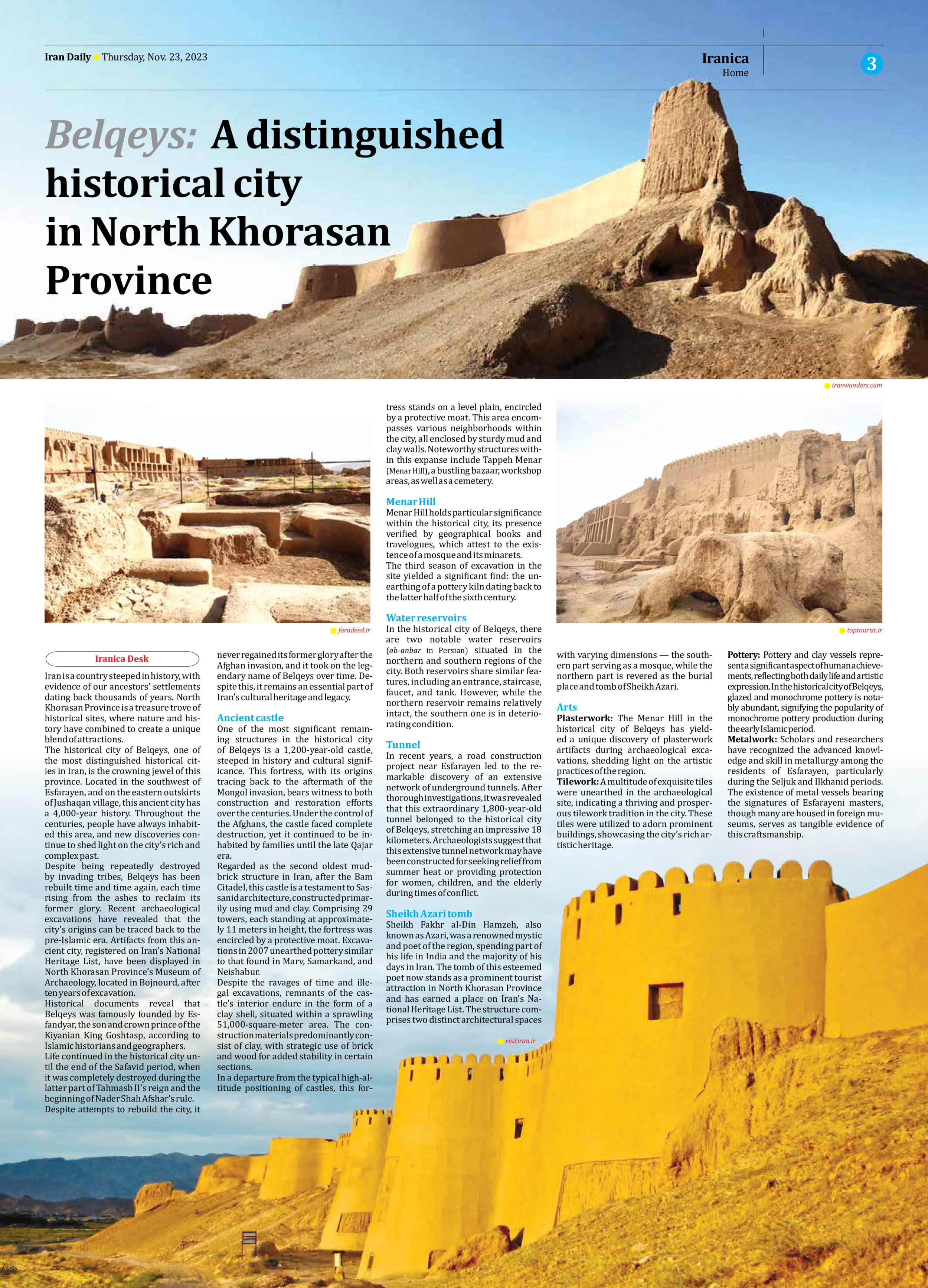
Belqeys: A distinguished historical city in North Khorasan Province
Iran is a country steeped in history, with evidence of our ancestors’ settlements dating back thousands of years. North Khorasan Province is a treasure trove of historical sites, where nature and history have combined to create a unique blend of attractions.
The historical city of Belqeys, one of the most distinguished historical cities in Iran, is the crowning jewel of this province. Located in the southwest of Esfarayen, and on the eastern outskirts of Jushaqan village, this ancient city has a 4,000-year history. Throughout the centuries, people have always inhabited this area, and new discoveries continue to shed light on the city’s rich and complex past.
Despite being repeatedly destroyed by invading tribes, Belqeys has been rebuilt time and time again, each time rising from the ashes to reclaim its former glory. Recent archaeological excavations have revealed that the city’s origins can be traced back to the pre-Islamic era. Artifacts from this ancient city, registered on Iran’s National Heritage List, have been displayed in North Khorasan Province’s Museum of Archaeology, located in Bojnourd, after ten years of excavation.
Historical documents reveal that Belqeys was famously founded by Esfandyar, the son and crown prince of the Kiyanian King Goshtasp, according to Islamic historians and geographers.
Life continued in the historical city until the end of the Safavid period, when it was completely destroyed during the latter part of Tahmasb II’s reign and the beginning of Nader Shah Afshar’s rule.
Despite attempts to rebuild the city, it never regained its former glory after the Afghan invasion, and it took on the legendary name of Belqeys over time. Despite this, it remains an essential part of Iran’s cultural heritage and legacy.
Ancient castle
One of the most significant remaining structures in the historical city of Belqeys is a 1,200-year-old castle, steeped in history and cultural significance. This fortress, with its origins tracing back to the aftermath of the Mongol invasion, bears witness to both construction and restoration efforts over the centuries. Under the control of the Afghans, the castle faced complete destruction, yet it continued to be inhabited by families until the late Qajar era.
Regarded as the second oldest mud-brick structure in Iran, after the Bam Citadel, this castle is a testament to Sassanid architecture, constructed primarily using mud and clay. Comprising 29 towers, each standing at approximately 11 meters in height, the fortress was encircled by a protective moat. Excavations in 2007 unearthed pottery similar to that found in Marv, Samarkand, and Neishabur.
Despite the ravages of time and illegal excavations, remnants of the castle’s interior endure in the form of a clay shell, situated within a sprawling 51,000-square-meter area. The construction materials predominantly consist of clay, with strategic use of brick and wood for added stability in certain sections.
In a departure from the typical high-altitude positioning of castles, this fortress stands on a level plain, encircled by a protective moat. This area encompasses various neighborhoods within the city, all enclosed by sturdy mud and clay walls. Noteworthy structures within this expanse include Tappeh Menar (Menar Hill), a bustling bazaar, workshop areas, as well as a cemetery.
Menar Hill
Menar Hill holds particular significance within the historical city, its presence verified by geographical books and travelogues, which attest to the existence of a mosque and its minarets.
The third season of excavation in the site yielded a significant find: the unearthing of a pottery kiln dating back to the latter half of the sixth century.
Water reservoirs
In the historical city of Belqeys, there are two notable water reservoirs (ab-anbar in Persian) situated in the northern and southern regions of the city. Both reservoirs share similar features, including an entrance, staircase, faucet, and tank. However, while the northern reservoir remains relatively intact, the southern one is in deteriorating condition.
Tunnel
In recent years, a road construction project near Esfarayen led to the remarkable discovery of an extensive network of underground tunnels. After thorough investigations, it was revealed that this extraordinary 1,800-year-old tunnel belonged to the historical city of Belqeys, stretching an impressive 18 kilometers. Archaeologists suggest that this extensive tunnel network may have been constructed for seeking relief from summer heat or providing protection for women, children, and the elderly during times of conflict.
Sheikh Azari tomb
Sheikh Fakhr al-Din Hamzeh, also known as Azari, was a renowned mystic and poet of the region, spending part of his life in India and the majority of his days in Iran. The tomb of this esteemed poet now stands as a prominent tourist attraction in North Khorasan Province and has earned a place on Iran’s National Heritage List. The structure comprises two distinct architectural spaces with varying dimensions — the southern part serving as a mosque, while the northern part is revered as the burial place and tomb of Sheikh Azari.
Arts
Plasterwork: The Menar Hill in the historical city of Belqeys has yielded a unique discovery of plasterwork artifacts during archaeological excavations, shedding light on the artistic practices of the region.
Tilework: A multitude of exquisite tiles were unearthed in the archaeological site, indicating a thriving and prosperous tilework tradition in the city. These tiles were utilized to adorn prominent buildings, showcasing the city’s rich artistic heritage.
Pottery: Pottery and clay vessels represent a significant aspect of human achievements, reflecting both daily life and artistic expression. In the historical city of Belqeys, glazed and monochrome pottery is notably abundant, signifying the popularity of monochrome pottery production during the early Islamic period.
Metalwork: Scholars and researchers have recognized the advanced knowledge and skill in metallurgy among the residents of Esfarayen, particularly during the Seljuk and Ilkhanid periods. The existence of metal vessels bearing the signatures of Esfarayeni masters, though many are housed in foreign museums, serves as tangible evidence of this craftsmanship.







